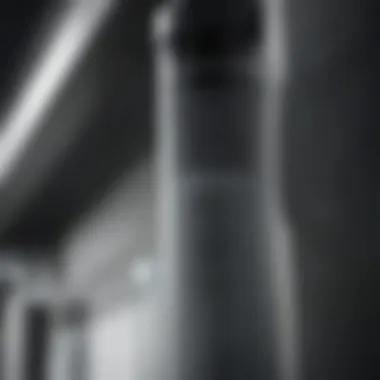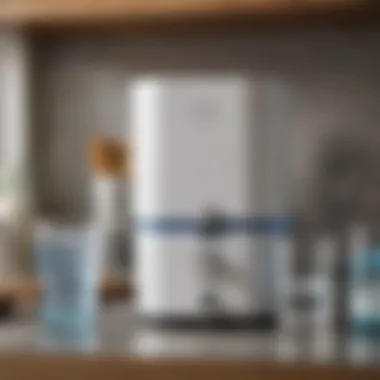The Best Kitchen Water Purifier: A Comprehensive Guide


Intro
In today's context, ensuring the purity of water in our kitchens has gained paramount importance. With the variety of contaminants present in tap water, it is crucial to focus on effective purification systems that suit the individual needs of homeowners. This guide endeavors to provide a lucid framework for understanding and selecting the best kitchen water purifiers available on the market. From evaluating purification technologies to understanding maintenance routines, every aspect is meticulously examined. This pathway aims to empower readers with the necessary knowledge to enhance water quality in their homes.
Design Inspiration
Water purifiers are not just functional devices; they also play a role in the overall design of your kitchen. Integrating your water purification system thoughtfully into your kitchen can maintain or even elevate aesthetic appeal.
Current Interior Design Trends
Currently, minimalist designs are trending in modern kitchens. Sleek lines and understated appliances allow for a tidy environment. Water purifiers, thus, should ideally align with minimalist aesthetics. Options like the Berkey Water Filter or Aquasana's filtration systems come in designs that might harmonize with this theme. Encouragingly, many brands are also focusing on discreet designs that blend seamlessly with cabinetry.
Color Palettes and Their Effects
Color plays an essential role in a kitchen's atmosphere. If your kitchen's palette is neutral, consider a water purifier in a matte finish, which could complement the overall tone without being obtrusive. Alternatively, if your kitchen boasts vibrant colors, a stainless steel purifier could add a touch of modern elegance without clashing with existing hues.
Understanding Water Purification Technologies
Each type of water purifier employs different technologies to enhance water quality. Homeowners should understand these technologies to make educated decisions. Here are key technologies:
- Activated Charcoal Filters: Effective in removing chlorine and improving taste.
- Reverse Osmosis Systems: Capable of removing a wide range of contaminants, including heavy metals.
- Ultraviolet Purification: Kills bacteria and viruses without chemicals, preserving taste and quality.
Knowing how each technology functions aids in determining which type best aligns with your water quality needs.
Maintenance Practices
Regular maintenance is an often overlooked aspect of owning a water purifier. Adhering to manufacturer guidelines ensures the longevity of the device. Moreover, common issues may arise, like reduced water flow or unusual tastes, often indicative of filter saturation.
General Maintenance Tips
- Filter Replacement: Regularly check and replace filters as recommended.
- Cleaning: Clean the purifier's exterior and components periodically to prevent buildup.
- Water Quality Testing: Conduct regular tests to ensure that water remains free from harmful contaminants.
"Maintaining your water purifier is just as crucial as its initial purchase."
Understanding Water Purity
Water purity is a critical factor in maintaining good health and ensuring the overall quality of daily life. For homeowners, it's essential to understand what constitutes clean water, especially when it comes to kitchen use. Clean water is not just a matter of taste; it also affects the safety of food preparation and beverage consumption. One overlooked aspect is how water purity influences the lifespan of kitchen appliances, as impurities in water can lead to build-up and long-term damage.
The Importance of Clean Water
Clean water is essential for daily functioning. It serves multiple roles, from drinking and cooking to cleaning. Contaminated water can negatively affect health by contributing to diseases and digestive issues. Using high-quality, purified water allows households not only to improve the taste of food but also to enhance the effectiveness of cleaning processes. This means brighter dishes, cleaner vegetables, and healthier meals.
Common Contaminants in Tap Water
Many contaminants find their way into tap water. These can include heavy metals like lead and mercury, bacteria, viruses, chlorine, and various chemicals. Each of these pollutants can originate from different sources, such as aging plumbing systems, agricultural runoff, and industrial waste. It is important for homeowners to know what is in their water supply. Testing water quality can reveal hazardous substances lurking in what appears to be clear water. Understanding these contaminants is the first step toward selecting an effective water purification system.
Health Implications of Contaminated Water
Contaminated water poses several health risks. Exposure to certain pollutants can lead to serious illnesses, particularly for vulnerable populations like children, the elderly, and individuals with weakened immune systems. For instance, lead in drinking water can result in developmental issues in children, while bacteria can cause gastrointestinal infections. These consequences make it imperative for homeowners to not only recognize potential dangers but also take proactive measures to ensure water purity. By doing so, they can significantly lower health risks and improve overall well-being.
"The quality of water directly impacts our life and health. Understanding water purity is crucial for making informed decisions."
Types of Water Purifiers
Water purifiers are essential for ensuring that the water you consume is safe and clean. Understanding the various types of water purifiers available can help you make an informed decision when selecting a system for your kitchen. Each type has its unique features and benefits, making them suitable for different needs and preferences. Knowing the distinctions among these purifiers not only aids in choosing the right one but also in understanding the purification process itself. This knowledge can significantly enhance your overall water quality, leading to improved health and hydration.
Reverse Osmosis Systems
Reverse osmosis systems are one of the most effective methods for purifying water. These systems use a semipermeable membrane that removes contaminants from water by applying pressure to force it through the membrane. This process can eliminate up to 99% of dissolved salts, bacteria, and other impurities. The benefit of reverse osmosis is its thoroughness; it is particularly effective for removing heavy metals, such as lead and arsenic, which can have severe health implications.


However, reverse osmosis systems also have some considerations. They tend to waste some water during the purification process. Additionally, they may require regular maintenance and filter changes to ensure continued effectiveness.
Activated Carbon Filters
Activated carbon filters work by adsorbing impurities from water. The porous nature of activated carbon allows it to trap contaminants, including pesticides and chlorine, improving taste and odor. These filters are widely appreciated for their ability to enhance the palatability of tap water. They are easy to install and require minimal maintenance, often only needing element changes every few months.
However, these filters do not remove dissolved minerals or heavy metals, which could be a drawback depending on your water quality. Thus, while they are excellent for taste improvement, they are not comprehensive purifiers by themselves.
Ultraviolet (UV) Purifiers
Ultraviolet purifiers utilize UV light to kill bacteria and viruses in water. This method is effective for disinfection, ensuring that harmful pathogens are rendered inactive. What’s notable about UV systems is that they do not change the chemistry of the water, maintaining beneficial minerals. However, these systems do not remove physical impurities; therefore, they are often used alongside other filtration methods to provide comprehensive purification.
One limitation is the need for electricity to operate the UV light, which may not be practical in areas with unreliable power supply. Regular bulb replacement is also necessary to maintain their effectiveness.
Distillation Units
Distillation units operate by boiling water and then condensing the steam back into a liquid. This method removes many contaminants, including heavy metals and biological pathogens. The main advantage is the high level of purity achieved through the distillation process, making it a reliable choice for those concerned about the quality of their water.
On the downside, distillation takes time. This process can be slow, often producing less water than other methods promptly. The energy cost used in boiling water may also increase utility bills. Additionally, beneficial minerals are removed, so remineralization could be necessary for better taste.
Ceramic Filters
Ceramic filters use a porous ceramic material to reduce particulates and bacteria. They are durable and can be cleaned and reused, making them eco-friendly. The structure of the ceramic filter traps microorganisms, ensuring that the water passing through is safe for consumption. These filters are especially useful in areas with unreliable water quality.
While effective, ceramic filters do have a specific limitation. They might not be as effective against chemical contaminants and dissolved solids. Regular cleaning is necessary to maintain their effectiveness, and improper maintenance can lead to bacteria growth on the filter surface.
Criteria for Choosing the Best Kitchen Water Purifier
Choosing the right kitchen water purifier involves thorough consideration of multiple factors that can influence both the quality of water and the user experience. Homeowners are becoming more aware of the role that clean water plays in their daily lives. As a result, understanding how to select the best water purification system becomes essential. This section will detailedly explore the key criteria that can aid in making an informed decision in this regard.
Assessment of Water Quality
Evaluating the quality of your water supply is a crucial step before investing in any water purifier. Different sources of water contain varying levels of contaminants, so it is necessary to determine what impurities exist in your tap water. Homeowners can conduct tests at home or hire professionals to assess water quality. A basic water test kit can help identify common contaminants like chlorine, lead, and bacteria. Knowing the specific contaminants will help in selecting a purifier that effectively targets those issues.
Flow Rate Considerations
The flow rate of a water purifier refers to the speed at which purified water is dispensed. It is an important factor for households that consume large amounts of water or have multiple users at peak times. Generally, the higher the flow rate, the more convenient the system will be. Some systems may produce water gradually, while others can provide instant access. For larger families or those who frequently host gatherings, looking for a purifier with an adequate flow rate is vital to meet the demands efficiently.
Purification Capacity and Maintenance
When considering a water purifier, understanding its purification capacity is key. This aspect measures how many gallons of water the system can purify over a specific time frame. Some purifiers offer a higher capacity suitable for larger households, while others are designed for minimal usage. Furthermore, maintenance requirements should also be taken into account. Systems with simple filter replacement processes are usually more user-friendly. Staying informed about how often filters need changing can also help in planning maintenance schedules more efficiently.
Cost and Budget Evaluation
Cost is a significant consideration when choosing a water purifier. Systems can vary greatly in price based on their type and features. It is essential to set a budget before shopping and to consider not only the initial purchase price but also long-term maintenance costs. Some systems may have higher upfront costs but lower maintenance expenses, making them more cost-effective over time. Analyzing the total cost of ownership for each purifier will help you make a more economical and informed decision.
Remember to balance quality with affordability to ensure that you are investing wisely in your health.
Reviews of the Best Kitchen Water Purifiers
In the realm of kitchen water purifiers, reviews hold significant importance. They serve as a compass for discerning homeowners, guiding them through the myriad options available in the market. A structured review offers clarity on product performance, efficiency, and user satisfaction. This section aims to distill complex information about various purifying systems, allowing readers to make informed decisions based on credibility and empirical feedback from users.
The best water purifiers are not just defined by their brands or price tags; instead, the benefits they provide stem from how they fit into individual needs around health, convenience, and budget. With these insights, one can select the most suitable purifier, ensuring cleaner drinking water and peace of mind.
Top Picks for Reverse Osmosis Systems
The reverse osmosis (RO) systems stand out in the market for their robust filtration capabilities. Models such as the APEC ROES-50 are highly regarded for their performance. This system boasts a five-stage filtration process that effectively removes contaminants like lead, chlorine, and fluoride.
"The efficiency of reverse osmosis systems is critical for households prioritizing pure water."


Factors to consider include:
- Filtration Stages: More stages usually correlate with better purity.
- Storage Capacity: Ensure it fits your daily water usage.
- Maintenance Requirements: Check if you are comfortable with regular filter replacements.
Highly Rated Activated Carbon Filters
Activated carbon filters are lauded for their ability to enhance taste and eliminate odors. The Brita Ultra Max is a favored choice among consumers. This system excels in removing chlorine and sediment, improving the overall flavor of drinking water.
When assessing activated carbon filters, here are crucial points to ponder:
- Carbon Quality: Higher quality generally leads to enhanced filtration.
- Filter Lifespan: Know how often the filter needs replacing.
- Size and Design: Ensure it fits well in your kitchen environment.
Recommended UV Purifiers
Ultraviolet (UV) purifiers, like the Aquasana AQ-UV, use light to kill microorganisms. This makes them an advisable option where biological contamination is a concern. They require minimal maintenance, as the UV lamp typically needs to be replaced only annually.
Key benefits of UV purifiers include:
- Effective Against Microbes: They can eliminate bacteria and viruses without chemicals.
- No Alteration of Taste: The original taste of water remains unaffected, as there are no added substances.
- Space Efficient: Many models are compact, saving precious kitchen space.
Best Distillation Options
Distillation units, such as the Megahome countertop distiller, offer another layer of purification. They boil water and then condense it back to a liquid, removing contaminants effectively.
Considerations for distillation systems include:
- Energy Consumption: These can consume more energy due to heating requirements.
- Water Production Rate: Assess how much water you need within a specific timeframe.
- Taste Alteration: Some users notice a difference in taste due to the removal of certain minerals.
Maintenance Practices for Water Purifiers
Maintaining your water purifier is crucial to ensure its efficient performance and longevity. Proper maintenance not only prolongs the lifespan of the device, but it also ensures that you are consuming safe and clean water. If a purifier is neglected, its filters can become saturated with contaminants, and its internal mechanisms can degrade. This outcome might lead to a decline in water quality, which can have health implications. Homeowners must prioritize maintenance to keep their water purifiers functioning optimally.
Regular Filter Changing Schedule
Establishing a regular filter changing schedule is vital for the effective operation of your water purifier. Different types of purifiers have different filter lifespans. For example, reverse osmosis systems typically require filter replacements every six months, while activated carbon filters may need changing every three to six months. Not adhering to these schedules can lead to a buildup of impurities that the filters are meant to remove.
It is beneficial to mark the dates on your calendar to remind you of when to change the filters. Consider logging the filter replacement dates in a maintenance journal. Some purifiers also have indicators that notify when filters need replacement.
- Reasons to change filters regularly:
- Maintains water taste and odor
- Ensures removal of contaminants
- Prevents system strain
System Cleaning and Sanitization
Cleaning and sanitization of the water purifier is equally important as changing the filters. Over time, mineral buildup, algae, or bacteria can develop in and around the system. This buildup might not only affect taste but also poses a risk of health concerns. Most manufacturers provide guidelines on how to clean the system safely.
A common approach is to use a mixture of vinegar and water for cleaning. It is essential to rinse thoroughly afterward to avoid any residual taste. Sanitize the systems every few months to eliminate bacteria. It's essential to consult the user manual for the appropriate cleaning materials, as some chemicals might damage the device.
"Regular cleaning is key to ensuring that every drop of water consumed is safe."
Performance Monitoring Techniques
Monitoring the performance of your water purifier is vital for understanding how well your device is functioning. Check for changes in water taste, color, or odor, as these can indicate that maintenance is required. Additionally, observe the flow rate of water.
If you notice a significant decrease in flow, it might signal that it's time to change the filters or clean the system. Some modern systems also come equipped with performance indicators that assess the health of the purifier.
To keep abreast of your water quality, consider periodic testing kits that measure total dissolved solids (TDS) or other contaminants. Regular performance checks will help you identify potential problems before they escalate.
- Key performance indicators to monitor:


- Water taste and odor
- Flow rate
- TDS levels
By prioritizing these maintenance practices, homeowners can ensure effective operation of their water purifiers, benefiting from clean and safe drinking water.
Misconceptions About Water Purifiers
Misunderstandings about water purifiers can lead to poor choices when selecting devices for home use. Clarifying these misconceptions is essential, as it helps homeowners make informed decisions about water filtration options tailored to their needs. A reliable understanding of how various water purifiers operate enables consumers to recognize what effectively removes contaminants and what may be ineffective or unnecessary. This section addresses two prevalent misconceptions: myths surrounding reverse osmosis systems and misunderstandings related to activated carbon filters.
Myths Surrounding Reverse Osmosis
Reverse osmosis is a popular purification process, yet it is often mischaracterized. One common myth is that reverse osmosis removes all essential minerals from water. While it is true that reverse osmosis does eliminate a significant amount of minerals, many systems are designed to add back essential elements after purification. This ensures that the water remains not only safe to drink but also nutritious.
Another false belief is that reverse osmosis systems are always costly and require excessive maintenance. In reality, there are various models suited for different budgets and space requirements. Many modern units are engineered for efficiency and user-friendliness, simplifying upkeep. It is important to read reviews and product details to find a system that meets both performance and budget considerations.
Debunking Activated Carbon Misunderstandings
Activated carbon filters are widely regarded for their advantages in removing specific contaminants, but some misconceptions persist. One prevalent belief is that activated carbon filters are sufficient for all types of water contamination. While they do excel at eliminating chlorine, sediment, and certain volatile organic compounds, they are less effective against heavy metals or bacteria. Homeowners should consider a multi-barrier system for comprehensive filtration.
Some users believe that activated carbon filters need replacement only when visibly dirty. However, relying solely on visual cues can be misleading. Carbon filters should be replaced periodically, often every six months, or as recommended by the manufacturer, to ensure optimal performance. Keeping track of filter changes is crucial to maintaining high water quality.
It is vital for consumers to be educated about their water purification options. Being informed helps avoid common pitfalls and leads to healthier choices.
In summary, dispelling these myths can significantly influence homeowners' decisions regarding water purification. A keen understanding of the capabilities and limitations of both reverse osmosis systems and activated carbon filters empowers individuals to select devices that genuinely meet their water purity needs.
The Future of Water Purification Technology
In today's world, the need for efficient and reliable water purification methods has never been greater. As homeowners focus on health and sustainability, the evolution of water purification technology is essential. This section highlights emerging trends and innovations that are shaping the future of kitchen water purifiers.
Emerging Trends in Water Purification
In the last few years, there have been several significant trends in the water purification market. Homeowners are increasingly seeking solutions that not only provide safe drinking water but also consider environmental and economic factors.
One notable trend is the shift towards smart technology integration in water purifiers. Devices with sensors now monitor water quality in real-time, providing users with updates regarding filtration effectiveness and when filters need replacement. This level of interactivity enhances user experience and ensures optimal performance.
Another important trend is the emphasis on multi-stage filtration systems. These systems combine different purification methods to enhance efficiency. For instance, a purifier may use activated carbon, reverse osmosis, and UV treatment sequentially for better contaminant removal. This approach increases consumer trust as it guarantees higher purity levels.
Moreover, many manufacturers are researching microbiological contamination removal techniques. Innovations in nanotechnology are enabling the development of smaller filtration systems that operate at a molecular level. These systems are efficient and often require less energy and space, making them suitable for modern kitchens where space may be a concern.
Innovations in Sustainable Purification Solutions
Sustainability is a critical consideration for many consumers today. Innovations in this area focus on reducing environmental impact while still ensuring water safety. Some advancements include the development of filter materials that can be easily recycled. Environmentally conscious homeowners appreciate products that align with their values.
Another innovation is the use of solar energy in water purification systems. This approach minimizes electricity costs and makes purification accessible in remote areas where electricity supply may be unreliable. Companies are exploring PV-powered reverse osmosis systems that cater to both urban and rural settings.
Furthermore, biodegradable filters are becoming more common. These filters use materials that break down naturally over time, thus preventing pollution associated with traditional plastic filters. Investing in such innovations allows consumers to play an active role in environmental protection.
"The incorporation of sustainability into water purification technologies is about more than just convenience. It reflects a commitment to maintaining our planet for future generations."
As we navigate an ever-changing environmental landscape, the future of water purification technology looks promising. There is a clear direction towards smarter, sustainable solutions, ensuring that homeowners can trust the quality of their drinking water while also caring for the planet.
Ending
In wrapping up an extensive exploration of kitchen water purifiers, it is crucial to emphasize the central message of this guide. Clean water is not merely a luxury; it is an essential component of health and well-being. The insights provided throughout the sections highlight the various types of purifiers available, the criteria for selection, and the necessary maintenance practices that sustain their efficiency.
Summarizing Key Points
To reinforce the knowledge gained, here are the key points discussed in this guide:
- Understanding Water Purity: A thorough awareness of what constitutes clean water and the contaminants commonly found in tap water.
- Types of Water Purifiers: An overview of the different purification technologies including reverse osmosis systems, activated carbon filters, and UV purifiers.
- Choosing the Right Purifier: Considerations on assessing water quality, flow rate, purification capacity, and budget.
- Maintaining Your System: Importance of regular filter changes and system cleaning to ensure longevity and performance.
- Common Misconceptions: Debunking myths surrounding water purification technologies to promote informed choices.
- Future Innovations: A glance at emerging trends and sustainable solutions in water purification.
Making an Informed Decision
Finally, when embarking on the journey to find the best kitchen water purifier, it is vital to make a decision based on sound information. Consider your specific needs, the quality of your local water supply, and your budget. Researching different products and reviewing customer opinions can also aid in this process. By understanding the technology behind each purifier and keeping maintenance practices in mind, homeowners can ensure they invest in a system that not only meets their immediate needs but also promotes long-term health.
It is a matter of health, taste, and quality of life. A decision regarding a water purifier is one that brings both immediate and lasting benefits.















